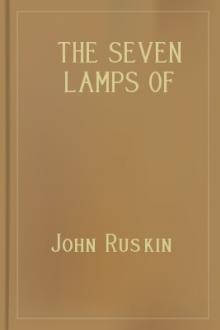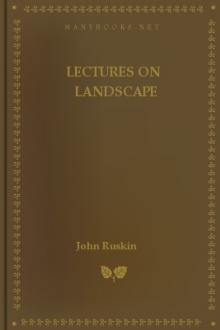The Seven Lamps of Architecture by John Ruskin (books like harry potter TXT) 📕

- Author: John Ruskin
- Performer: -
Book online «The Seven Lamps of Architecture by John Ruskin (books like harry potter TXT) 📕». Author John Ruskin
Traceries and Mouldings from Rouen and Salisbury.
XXVII. This rule of supremacy applies to the smallest as well as to the leading features: it is interestingly seen in the arrangement of all good mouldings. I have given one, on the opposite page, from Rouen cathedral; that of the tracery before distinguished as a type of the noblest manner of Northern Gothic (Chap. II. § XXII.). It is a tracery of three orders, of which the first is divided into a leaf moulding, fig. 4, and b in the section, and a plain roll, also seen in fig. 4, c in the section; these two divisions surround the entire window or panelling, and are carried by two-face shafts of corresponding sections. The second and third orders are plain rolls following the line of the tracery; four divisions of moulding in all: of these four, the leaf moulding is, as seen in the sections, much the largest; next to it the outer roll; then, by an exquisite alternation, the innermost roll (e), in order that it may not be lost in the recess and the intermediate (d), the smallest. Each roll has its own shaft and capital; and the two smaller, which in effect upon the eye, owing to the retirement of the innermost, are nearly equal, have smaller capitals than the two larger, lifted a little to bring them to the same level. The wall in the trefoiled lights is curved, as from e to f in the section; but in the quatrefoil it is flat, only thrown back to the full depth of the recess below so as to get a sharp shadow instead of a soft one, the mouldings falling back to it in nearly a vertical curve behind the roll e. This could not, however, be managed with the simpler mouldings of the smaller quatrefoil above, whose half section is given from g to g2; but the architect was evidently fretted by the heavy look of its circular foils as opposed to the light spring of the arches below: so he threw its cusps obliquely clear from the wall, as seen in fig. 2, attached to it where they meet the circle, but with their finials pushed out from the natural level (h, in the section) to that of the first order (g2) and supported by stone props behind, as seen in the profile fig. 2, which I got from the correspondent panel on the buttress face (fig. 1 being on its side), and of which the lower cusps, being broken away, show the remnant of one of their props projecting from the wall. The oblique curve thus obtained in the profile is of singular grace. Take it all in all, I have never met with a more exquisite piece of varied, yet severe, proportioned and general arrangement (though all the windows of the period are fine, and especially delightful in the subordinate proportioning of the smaller capitals to the smaller shafts). The only fault it has is the inevitable misarrangement of the central shafts; for the enlargement of the inner roll, though beautiful in the group of four divisions at the side, causes, in the triple central shaft, the very awkwardness of heavy lateral members which has just been in most instances condemned. In the windows of the choir, and in most of the period, this difficulty is avoided by making the fourth order a fillet which only follows the foliation, while the three outermost are nearly in arithmetical progression of size, and the central triple shaft has of course the largest roll in front. The moulding of the Palazzo Foscari (Plate VIII., and Plate IV. fig. 8) is, for so simple a group, the grandest in effect I have even seen: it is composed of a large roll with two subordinates.
XXVIII. It is of course impossible to enter into details of instances belonging to so intricate division of our subject, in the compass of a general essay. I can but rapidly name the chief conditions of right. Another of these is the connection of Symmetry with horizontal, and of Proportion with vertical, division. Evidently there is in symmetry a sense not merely of equality, but of balance: now a thing cannot be balanced by another on the top of it, though it may by one at the side of it. Hence, while it is not only allowable, but often necessary, to divide buildings, or parts of them, horizontally into halves, thirds, or other equal parts, all vertical divisions of this kind are utterly wrong; worst into half, next worst in the regular numbers which more betray the equality. I should have thought this almost the first principle of proportion which a young architect was taught: and yet I remember an important building, recently erected in England, in which the columns are cut in half by the projecting architraves of the central windows; and it is quite usual to see the spires of modern Gothic churches divided by a band of ornament half way up. In all fine spires there are two bands and three parts, as at Salisbury. The ornamented portion of the tower is there cut in half, and allowably, because the spire forms the third mass to which the other two are subordinate: two stories are also equal in Giotto's campanile, but dominant over smaller divisions below, and subordinated to the noble third above. Even this arrangement is difficult to treat; and it is usually safer to increase or diminish the height of the divisions regularly as they rise, as in the Doge's Palace, whose three divisions are in a bold geometrical progression: or, in towers, to get an alternate proportion between the body, the belfry, and the crown, as in the campanile of St. Mark's. But, at all events, get rid of equality; leave that to children and their card houses: the laws of nature and the reason of man are alike against it, in arts, as in politics. There is but one thoroughly ugly tower in Italy that I know of, and that is so because it is divided into vertical equal parts: the tower of Pisa.12
XXIX. One more principle of Proportion I have to name, equally simple, equally neglected. Proportion is between three terms at least. Hence, as the pinnacles are not enough without the spire, so neither the spire without the pinnacles. All men feel this and usually express their feeling by saying that the pinnacles conceal the junction of the spire and tower. This is one reason; but a more influential one is, that the pinnacles furnish the third term to the spire and tower. So that it is not enough, in order to secure proportion, to divide a building unequally; it must be divided into at least three parts; it may be into more (and in details with advantage), but on a large scale I find three is about the best number of parts in elevation, and five in horizontal extent, with freedom of increase to five in the one case and seven in the other; but not to more without confusion (in architecture, that is to say; for in organic structure the numbers cannot be limited). I purpose, in the course of works which are in preparation, to give copious illustrations of this subject, but I will take at present only one instance of vertical proportion, from the flower stem of the common water plantain, Alisma Plantago. Fig. 5, Plate XII. is a reduced profile of one side of a plant gathered at random; it is seen to have five masts, of which, however, the uppermost is a mere shoot, and we can consider only their relations up to the fourth. Their lengths are measured on the line A B, which is the actual length of the lowest mass a b, A C=b c, A D=c d, and A E=d e. If the reader will take the trouble to measure these lengths and compare them, he will find that, within half a line, the uppermost A E=5/7 of A D, A D=6/8 of A C, and A C=7/9 of A B; a most subtle diminishing proportion. From each of the joints spring three major and three minor branches, each between





Comments (0)